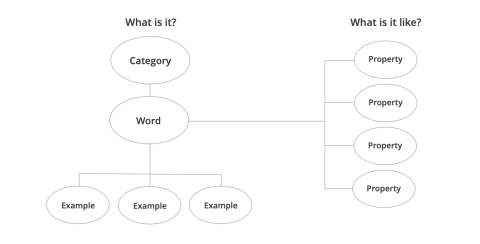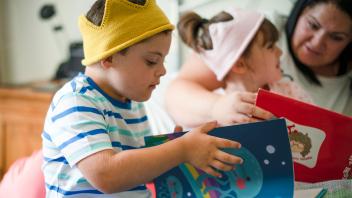A new genre of literature, the combined text, is becoming readily available. It combines a story format and an expository or informational format within one book. For example, the Magic School Bus books combine fantasy stories, such as a class taking a field trip to the ocean floor (Cole, 1992), with information in the form of reports and reference charts posted in the illustrated classroom. Snowflake Bentley (Martin, 1998), a Caldecott Medal winner, presents the biography of Wilson Bentley in narrative format as it details the development of a specialized photography technique through marginal notes. More recently, Cook-a-Doodle-Doo! (Stevens & Crummel, 1999) combines the tale of farm animals cooking up strawberry shortcake with informational text about cooking and using cookbooks. In addition, books such as Stellaluna (Cannon, 1993) place informational text about characters’ real-life counterparts at the end of the fantasy, but both text formats are still within one book.
Effective use
As combined-text books gain popularity, effective use of them in the classroom requires special consideration. In a study to identify effective reading and instructional strategies specific to combined-text use within thematic units, we became aware of difficulties teachers and students experience. Both teachers and students often were overwhelmed by the number of concepts in combined-text books and by the problem of how to navigate the text formats. Lacking instruction on best practices, teachers were hesitant about using the combined-text format.
Primary students were seldom able to distinguish fantastical elements in stories from science concepts. For example, second and fifth graders insisted that bats’ eyes produce light much the way car headlights produce light. A significant illustration and the story line in Stellaluna (Cannon, 1993) reinforced students’ beliefs that were rooted in horror films and television shows. Similar misconceptions occurred when teachers used the Magic School Bus book about the ocean floor (Cole, 1992). Students could not fully comprehend the food chain due to the fantasy. Weeks after a reading of that combined text, students could recite memorized elements of the food chain, but they could not put humans into the sequence. This is significant because human consumption of seafood is discussed in the fantasy trip.
Traditionally, developing interdisciplinary units meant using combinations of narrative texts, expository or informational texts, and picture books. These combinations are identified as text sets (Smith & Johnson, 1994) and examine attributes related to a particular topic. The use of combined-text books provides unit developers with another option. The combined-text book becomes a focus book to help link related books to a particular topic. It is particularly useful as a read-aloud while other books in the text set are used throughout the unit.
The instructional strategies described here are such that teachers can employ them within interdisciplinary units when using combined-text books with their students. Such a set of instructional strategies informs students of the purpose for reading particular texts and how reading strategically builds upon existing concept-knowledge domains (Martens, Flurkey, Meyer, & Udell, 1999; Pajares, 1992; Paris, Lipson, & Wixson, 1983). The instructional strategies are coordinated to help teachers and students better identify superordinate, target, coordinate, and subordinate concepts (Kauchak & Eggen, 1998; Sousa, 2001; Vacca & Vacca, 1996). Clearly identifying these concepts allows teachers in the United States to use materials most efficiently in meeting state and national education standards.
Recommended strategies
Reading combined-text books is much like peeling an onion. When used for instruction, these books are best read in layers. The layers include (a) illustrations; (b) informational text; (c) narrative text; and (d) additional details, such as sketches and page borders. Addressing various layers individually during read-alouds provides a perfect opportunity to model revisiting text for various purposes. Addressing various layers helps students develop concepts targeted by the teacher. This foundation provides necessary knowledge for students to recognize and appreciate fantastical elements. It also means that these concept-dense books are best used over several days rather than a single 45-minute period. All of this can be accomplished using existing strategies. Following is a suggested set of strategies we found useful with combined-text books. Specific strategies, however, should be selected on the basis of their match with individual books and the instructional needs of students. (See Summary of Recommendations.)
| Summary of recommendations | ||
|---|---|---|
| Session | Layer | Suggested strategies |
| Initial | Illustrations | Picture walk PReP |
| Second | Informational text | Zoom in, zoom out CD map |
| Third | Narrative text | Interactive read-aloud Story map |
| Fourth | Sketches and borders | Shared writing Semantic map |
Illustrations
Careful attention to illustrations helps students develop visual literacy and match accurate concepts to text. This is accomplished easily using a picture walk to activate and build schemata prior to reading text. A picture walk prompts students’ statements and queries about topics the informational text addresses.
A traditional picture walk can be paired with the Pre-Reading Plan (PReP; Langer, 1981) to help teachers determine students’ misconceptions or questions related to concepts in the book. As the group brainstorms about target concepts during the picture walk, the teacher pauses to create a list of responses on chart paper. The list represents the combined knowledge of the group related to the target concept, but individual student names are also recorded beside contributions. The teacher probes further by asking students to explain what prompted their responses. After the picture walk session the teacher analyzes students’ responses. It is this analysis step that helps teachers identify potential misconceptions that must be directly addressed in subsequent instructional sessions with expository or informational text. Lists produced with the PReP remain available as reference materials in subsequent sessions with the book.
Informational text
With information readily available in the book, misconceptions can be avoided. Using a strategy such as “zoom in, zoom out” (Harmon & Hedrick, 2000) allows teachers and students to identify the most salient, or target, concepts. In The Magic School Bus on the Ocean Floor (Cole, 1992), for example, zoom in, zoom out might help students identify elements within a food chain. A second target concept might be surfaces within the ocean biome.
The concept of definition map (CD map) described in Vacca and Vacca (1996) is an effective strategy to help students and teachers identify levels of concepts and see interrelationships among concepts. The Figure provides a visual reference of the relationships among important concepts that students identify during the zoom in, zoom out process. Begin by placing a target concept in the most central space. Build up to identify the superordinate concept. The coordinate concepts are determined after the relationship between the superordinate and target concept is identified. As informational text is read, the group adds items that serve as examples and describes attributes of the target concept. It is important to identify attributes of the target and not the superordinate concept. By building a meaningful, factual base of information prior to reading the fantasy, students are able to better identify fantastical elements in the narrative text.
Concept of Definition Map Template

Narrative text
Once a foundation of factual information is established, the group can focus on the narrative text. An interactive read-aloud (Barrentine, 1996) provides an opportunity for students to apply concepts they have learned to a fantasy. As students identify words and concepts in the story that are not clearly understood, the teacher helps them mediate for one another. Students identify elements in the fantasy that depend on the facts and concepts established in earlier encounters with the combined-text book or from other sources.
A traditional story map helps students identify significant events from the fantasy. Recording the events with other important information, such as characters’ names and setting, provides another opportunity to highlight fantasy elements. The story map can be structured in such a way that students identity content area concepts that make the fantasy plausible. For example, knowledge about bats hanging upside down and birds sitting right side up makes a critical scene plausible in Stellaluna (Cannon, 1993).
Sketches and borders
As a final group visit with the combined-text book, the teacher and students have an opportunity to summarize concepts by reviewing border illustrations and any diagrams or sketches of interest. Important content area concepts are generally represented in all of these visual forms. This step provides an opportunity for students to connect target concepts to related superordinate, coordinate, and subordinate concepts introduced through the set of readings. Students’ understandings are easily represented through shared writing. Students generate ideas that are recorded on chart paper by the teacher or a small-group scribe. Charts are then posted to provide reference points as the unit of instruction continues.
A second strategy that effectively helps students use additional details to summarize is the semantic web. After the group revisits the combined text by looking at page borders, diagrams, and sketches, the members brainstorm attributes that relate to the target concept. These additional details help students organize attributes they generate to reinforce relationships between content area information and fantasy.
Potential benefits
Combined-text books have the potential to increase students’ knowledge base with a variety of topics while students apply that knowledge to a narrative tale. Effective use of this combined format places unique demands on both teacher and students. Teachers need to pay careful attention to concepts that the story format and the informational format share. They then can make use of a variety of strategies as they read and revisit the book and enhance students’ simultaneous development of facts, concepts, and stories.
